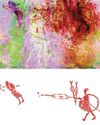
THE SOUTHERN ITALIAN region of Puglia rolls across seemingly endless hills of golden grain that stretch in every direction. Bordered by the azure waters of the Adriatic and Ionian Seas, this area at the heel of Italy is home to the bustling ports of Bari and Monopoli. Yet away from the coast and past the fortified medieval cities of Ostuni and Alberobello, the sunbaked landscape begins to feel uninhibited. Moving deeper into Puglia’s interior, the towns give way to single farmhouses, which, in turn, disappear, leaving only the gently waving rows of wheat that guard an agricultural legacy going back more than 2,000 years.
At the end of a two-track road that winds around ravines and through cultivated fields of wheat and chickpeas, a line of square trenches cuts deep into the rich soil. Under neat rows of modern crops lies the ancient site of Vagnari, named after an eighteenth-century Masseria, or farmhouse, that sits abandoned nearby. Here, between the first and early fourth centuries a.d., a succession of Roman emperors owned a 6,000-acre farming estate, the remains of which are only now beginning to be uncovered. Although such imperial farming estates are known to have existed throughout the empire, Vagnari is the first to be excavated, providing new insight into how a rural farm supplied emperors’ needs and provided them with a source of revenue. “Whether in Italy, North Africa, or anywhere else in the Roman Empire, imperial estates are grossly under-explored,” says archaeologist Maureen Carroll of the University of Sheffield. “We have ancient written evidence, such as inscriptions and historical texts, but that’s all that anybody has ever concentrated on. The only way to learn more is to excavate.”
This story is from the November/December 2019 edition of Archaeology.
Start your 7-day Magzter GOLD free trial to access thousands of curated premium stories, and 8,500+ magazines and newspapers.
Already a subscriber ? Sign In
This story is from the November/December 2019 edition of Archaeology.
Start your 7-day Magzter GOLD free trial to access thousands of curated premium stories, and 8,500+ magazines and newspapers.
Already a subscriber? Sign In

A Very Close Encounter
New research has shown that human figures painted in red on a rock art panel in central Montana depict individuals engaged in a life-or-death encounter during an especially fraught historical moment.

A Sword for the Ages
A zigzag pattern, now tinged with the green-blue patina of oxidized metal, adorns the octagonal hilt of a rare sword dating to the Middle Bronze Age in Germany (1600-1200 B.C.) that was recently excavated in the Bavarian town of Nördlingen.

Ancient Egyptian Astrology
For centuries, layers of soot have coated the ceilings and columns in the entrance hall of Egypt's Temple of Esna. Now, an Egyptian-German team of researchers, led by Hisham El-Leithy of the Egyptian Ministry of Tourism and Antiquities and Christian Leitz of the University of Tübingen, is restoring the temple's vibrant painted reliefs to their original brilliance.

BRONZE AGE POWER PLAYERS
How Hittite kings forged diplomatic ties with a shadowy Greek city-state

RITES OF REBELLION
Archaeologists unearth evidence of a 500-year-old resistance movement high in the Andes

Secrets of Egypt's Golden Boy
CT scans offer researchers a virtual look deep inside a mummy's coffin

When Lions Were King
Across the ancient world, people adopted the big cats as sacred symbols of power and protection

UKRAINE'S LOST CAPITAL
In 1708, Peter the Great destroyed Baturyn, a bastion of Cossack independence and culture

LAPAKAHI VILLAGE, HAWAII
Standing beside a cove on the northwest coast of the island of Hawaii, the fishing village of Lapakahi, which is surrounded by black lava stone walls, was once home to generations of fishers and farmers known throughout the archipelago for their mastery of la'au lapa'au, or the practice of traditional Hawaiian medicine. \"

A MORE COMFORTABLE RIDE
Although the date is much debated, most scholars believe people 5,000 years ago. For thousands of years after that, they did so without saddles. \"In comparison with horse riding, the development of saddles began relatively late, when riders began to care more about comfort and safety in addition to the horse's health,\" says University of Zurich archaeologist Patrick Wertmann.